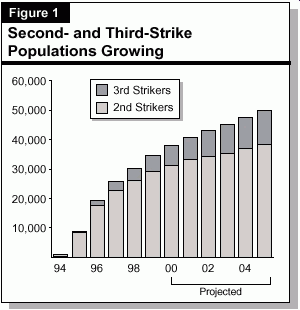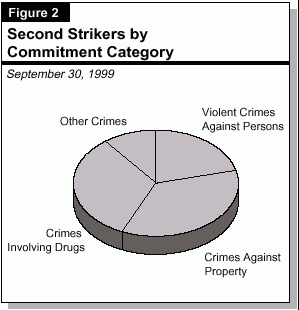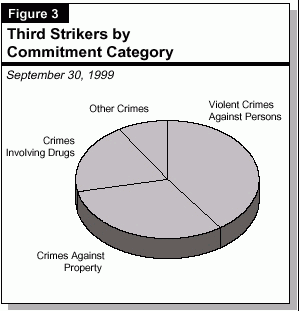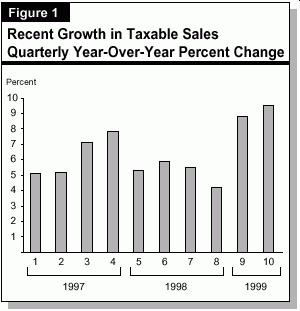

In March 1994, the "Three Strikes and You're Out" criminal sentencing measure was signed into law. Now, five years after its enactment, almost 50,000 inmates have been imprisoned under this law. In this issue of Cal Update, we examine the trends in the Three Strikes inmate population in the California Department of Corrections (CDC). The information presented in this piece provides the most recent information on the numbers of "strikers" in prison, where they came from, and the projections for the future. It is not an analysis of costs or benefits of the law. The Legislature passed SB 873 (Vasconcellos) to require such a study, but the measure was vetoed by the Governor.
The law, which was also passed by the voters as Proposition 184 in the November 1994 election, established substantially longer prison sentences for persons who have previously been convicted of a violent or serious crime (violent crimes are generally defined as crimes against persons; serious crimes include all violent crimes, plus one property crime--first degree burglary). Specifically, a person who committed one prior violent or serious offense and who commits any new felony can receive twice the normal prison sentence for the new felony (these are "second strikers"). A person who committed two or more prior violent or serious offenses and who commits any new felony (a "third striker") receives 25 years to life in prison. In addition, strikers are required to serve 80 percent of their prescribed sentence before release, compared with other offenders who can reduce the time they serve by as much as 50 percent.
As of the end of September 1999, about 43,800 inmates had been admitted to state prison for a second strike and about 5,700 inmates had been admitted to state prison for a third strike. Over the past three years, the admission trends for second and third strikers has been stable, with between 700 and 900 second strikers and about 100 third strikers admitted to prison each month.
More than 10,000 second strikers have already been released from prison to parole. These offenders were probably convicted of low-level offenses which resulted in relatively short prison terms, even with the doubling of the sentences prescribed under the Three Strikes law. Third strikers, on the other hand, receive sentences of at least 25 years to life, and thus none of these offenders has been released on parole.
It is important to remember that the Three Strikes law did not establish new crimes but rather simply provided for longer prison sentences. Thus, many of the offenders sent to prison under the law would probably have come to prison for the offense they committed. However, they serve much longer prison sentences than they might have otherwise served in the absence of the Three Strikes law.
Although the number of second and third strikers entering prison each month remains relatively stable, the fact that these offenders serve much longer sentences means that their population totals will grow. The most recent inmate population projections from CDC predict steady growth in the second- and third-strike populations.
Specifically, CDC projects that the second-striker population will reach about 31,300 by June 30, 2000, and increase further to about 38,100 by June 30, 2005. The department projects that the third-striker population will reach about 6,600 by June 30, 2000, and increase to more than 12,000 by June 30, 2005. Figure 1 shows the actual and projected numbers of strikers.

It should be noted that CDC's projections have generally overestimated the number of strikers in prison. The gap in projections and actual numbers of inmates has steadily closed, however, as the department has gained greater experience in projecting the population.
Crimes are generally classified in four categories: violent crimes against persons, crimes against property, drug-related crimes, and other crimes that are not classified in one of the other categories. Specific offenses fall within each category. For example, assault is considered to be a crime against a person and burglary is considered to be a property crime. Most second and third strikers are committed to prison for nonviolent property or drug crimes, as shown in Figures 2 and 3.


While the largest category of commitment offenses for third strikers (40 percent) is violent crimes against persons, the largest number of second strikers falls into the property crime category (36 percent), followed closely by the drug offense category (33 percent).
The most common second-strike offense is the possession of a controlled substance (20 percent of total second strikers) followed by petty theft with a prior theft (10 percent).
The most common commitment offense for third strikers is robbery (18 percent of total third strikers) followed by first degree burglary (11 percent).
The numbers shown above document the most serious new commitment offense, not the full criminal history of the offender.
County district attorneys retain significant discretion to determine whether to charge an offender under the law. Figure 4 (see page 4) shows that commitment rates for second and third strikers are not always reflective of an individual county's general inmate commitment rates. For example, as Figure 4 shows, Los Angeles County sends about 42 percent of the second and third strikers to state prison, but 35 percent of the total prison population.
| Figure 4 | |||
| County Commitment Patterns Vary | |||
| (Counties With Populations in Excess of 700,000) | |||
| Total Prison | Second Strikers | Third Strikers | |
| Alameda | 3.0% | 1.3% | 1.5% |
| Contra Costa | 1.5 | 1.6 | 1.2 |
| Fresno | 3.2 | 2.7 | 2.7 |
| Los Angeles | 35.4 | 42.4 | 41.5 |
| Orange | 5.3 | 5.4 | 5.4 |
| Riverside | 5.3 | 4.4 | 3.8 |
| Sacramento | 4.4 | 4.6 | 5.5 |
| San Bernardino | 5.8 | 4.7 | 5.7 |
| San Diego | 8.1 | 10.9 | 4.7 |
| San Francisco | 1.7 | 0.8 | 0.5 |
| San Mateo | 1.1 | 1.3 | 0.9 |
| Santa Clara | 3.4 | 4.0 | 4.7 |
| Ventura | 1.3 | 1.2 | 0.8 |
The discrepancies between commitment rates probably result from variations in charging practices of county prosecutors and sentencing patterns of county courts. For example, both the Counties of Alameda and San Francisco have generally chosen to restrict prosecutions of persons as third strikers to those accused of committing a new violent or serious offense, rather than any felony offense as the law permits. Consequently, the percentage of inmates they contribute to the second- and third-strike population is smaller than the percentage of inmates they supply to the general population.
When comparing the demographic characteristics of second and third strikers to the general prison population, a few trends emerge:
As the second- and third-strike inmate population has grown, it has become a significantly larger share of the state's overall prison population. In fact, second and third strikers are the fastest growing portions of the prison population. As of June 30, 1996, second and third strikers comprised about 14 percent of the total felon prison population. By June 30, 1999, that figure was 22 percent. By next year, CDC projects that one in four inmates will be in state prison under a second- or third-strike sentence, and that figure will reach about 28 percent by June 30, 2005.
This has occurred at the same time that the largest portion of the prison population--those inmates with determinate prison sentences--has declined substantially. Moreover, the other two categories of felons--parole violators returned to prison and non-third-strike inmates serving life sentences--has remained relatively stable, as Figure 5 shows.
The growing number of strikers continues to have significant implications for the state's prison system. Although the growth in the prison population has slowed in recent years, the second- and third-strike population continues to grow substantially. This growth will have implications for the costs, operation, and security needs of the prison system. For example, the growth in third strikers, who serve life terms, will increase pressure for adding high security beds in the prisons. Similarly, the state will need to make long-term plans to develop criteria and programming for third strikers who will eventually be eligible for parole.
Contact--Jennifer Chubinski, Dan
Carson or
Craig Cornett--(916) 445-4660
The California economy is currently expanding at a robust pace, and these economic gains are boosting state tax receipts. During the first three months of the current fiscal year, total General Fund revenues are almost $500 million relative to the 1999-00 Budget Act forecast. While worrisome reports on inflation and the recent declines in the stock market could portend slower economic growth in the future, the strong current revenue trends suggest that revenues in 1999-00 will exceed the budget estimate, potentially by a substantial margin.
In mid-November, our office will be releasing its fall fiscal forecasting report. This report will provide our updated economic forecast and fiscal projections for 1999-00 and the forthcoming budget year.
The Nation. The U.S. economy continues to expand at a strong pace, led by major increases in consumer expenditures on automobiles and other durable goods, and continued healthy increases in business investment. The current "consensus" forecast calls for real gross domestic product (GDP) growth of 3.8 percent in 1999. This increase is about the same as last year, and is slightly above the 1999-00 Budget Act forecast of 3.6 percent.
On the downside, there is growing evidence that sustained economic growth is starting to put upward pressure on inflation. For example, the producer price index jumped 1.1 percent in September, led by major increases in food, energy, and new car prices. Concerns over growing price pressures have already translated into higher interest rates and lower stock prices. Further significant price increases would pose a risk to the strength of future economic expansion.
California. Like the nation, the California economy is continuing to grow at a relatively strong pace. Wage and salary employment during the first nine months of 1999 is up by over 3.5 percent from the first nine months of 1998, led by gains in the construction and services industries. As a result of these gains, the California unemployment rate fell to 4.9 percent in September, the lowest level since 1970.
In other developments, California taxable sales increased by over 9 percent during the first half of 1999 compared to the first half of 1998, the largest increase in over a decade (see Figure 1). In addition, home sales and new building activity have continued to increase.

General Fund revenues during the first three months of 1999-00 were up by $497 million (3.6 percent) from the budget forecast. During this period, General Fund tax receipts were up by an even stronger $602 million, reflecting gains in each of the state's major tax sources. This was partially offset by nontax receipts, which were down by $105 million. This partly reflected temporary cash-flow factors which will be reversed in the months ahead. Regarding individual tax revenue sources:
Contact--Brad Williams--(916) 324-4942
| About the LAO
California Update is published monthly--except January and February--by the Legislative Analyst's Office (LAO). The LAO is a nonpartisan office which provides fiscal and policy information and advice to the legislature. The Legislative Analyst's Office is located at 925 L Street, Suite 1000, Sacramento, CA 95814. |
Need an LAO Report?
www.lao.ca.gov |
Want to Subscribe to LAO
Publications?
|